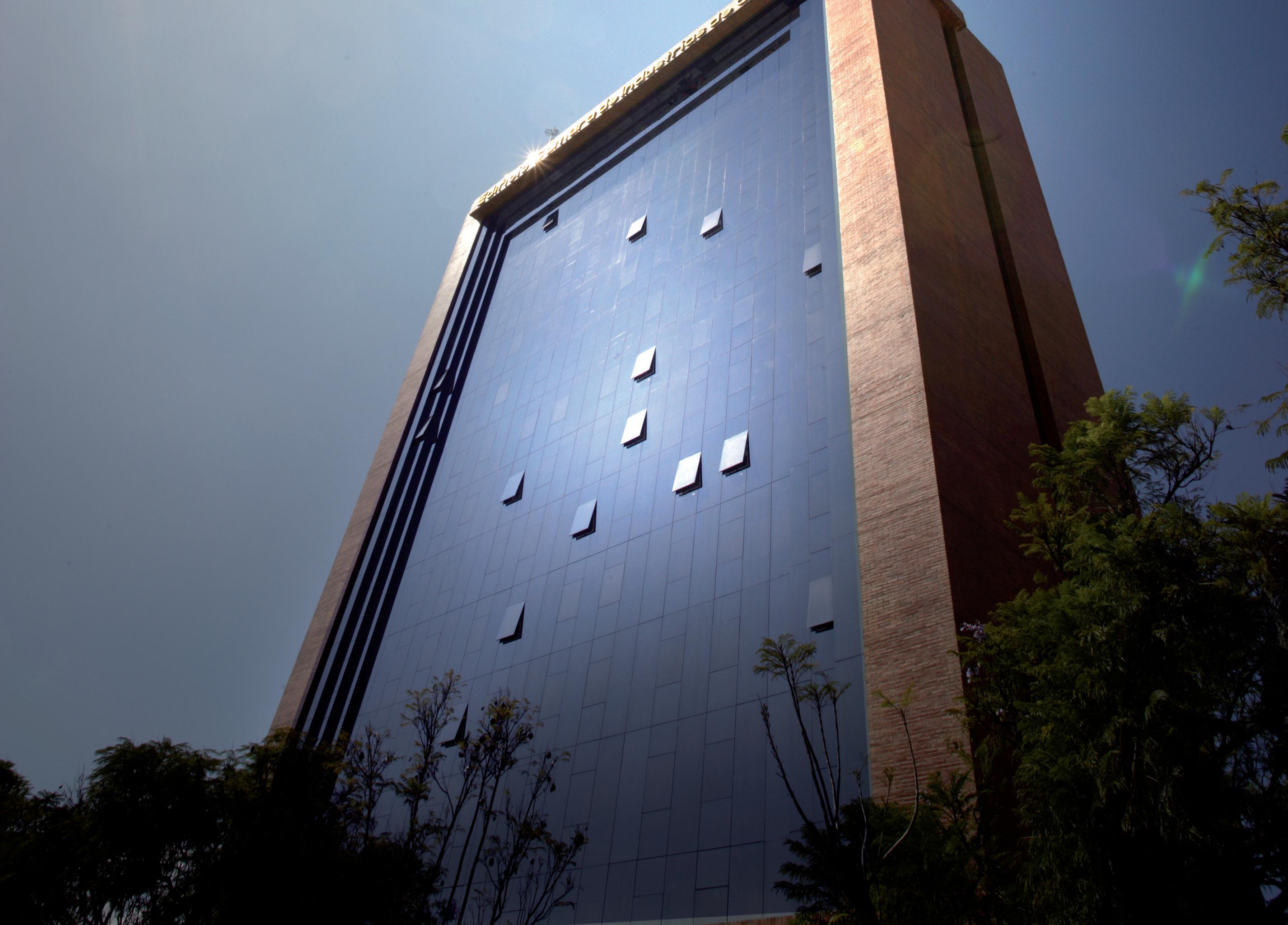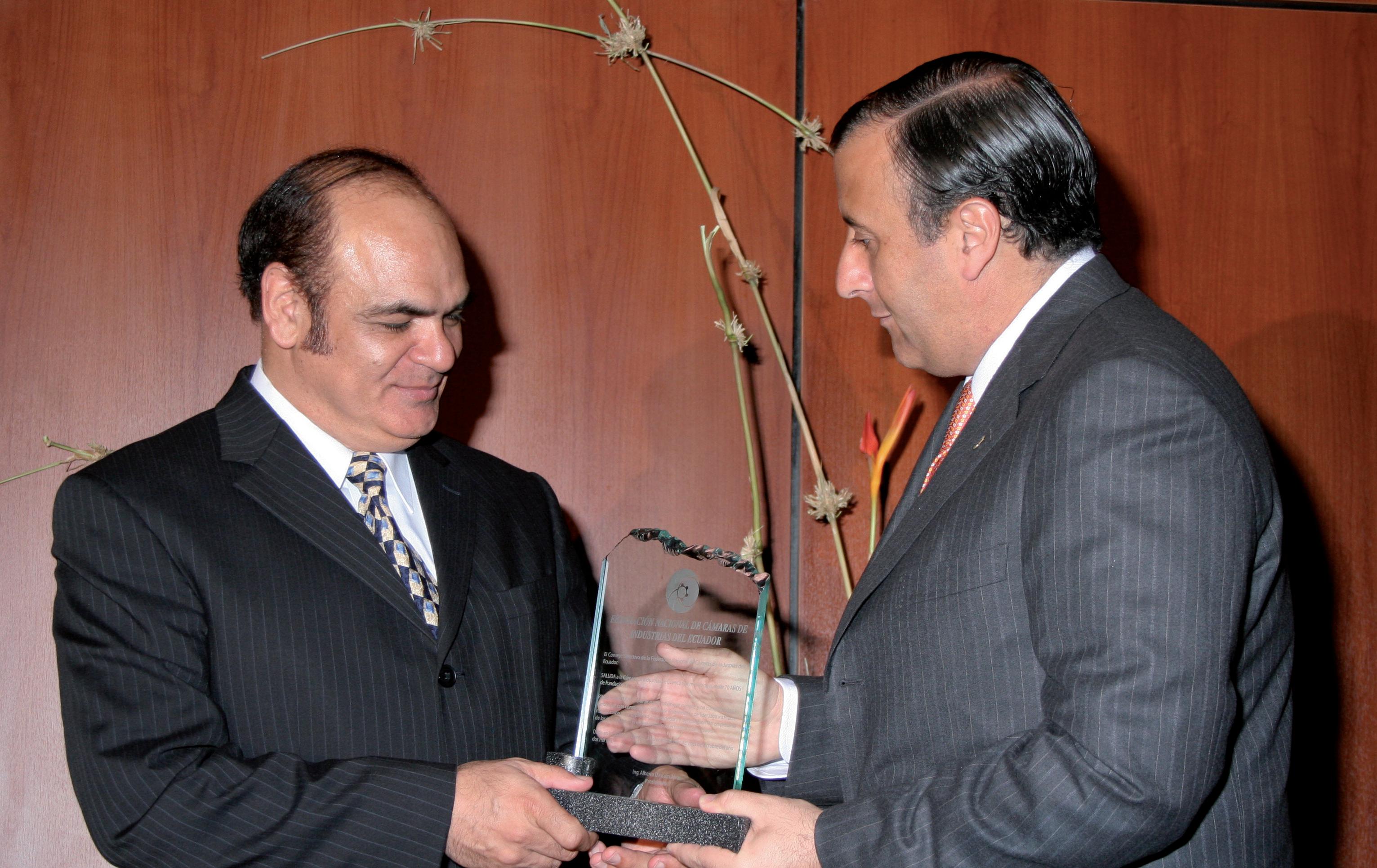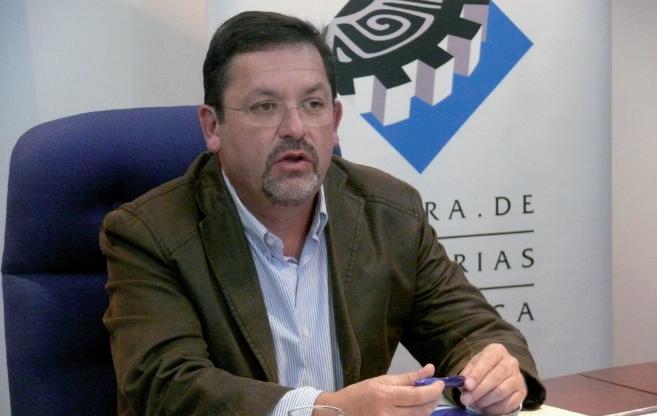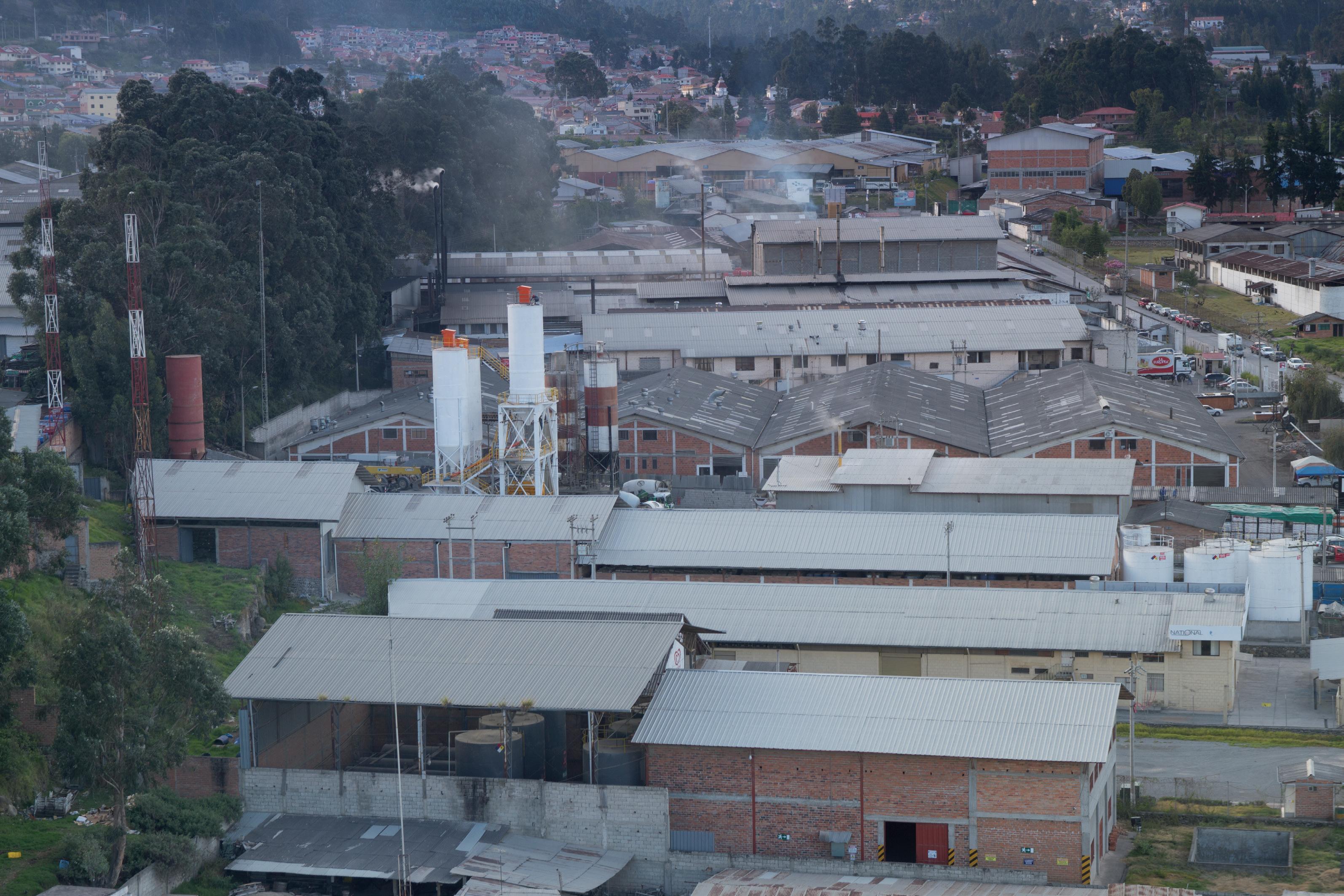
18 minute read
TRABAJO ESTABLE PARA LOS MORLACOS STABLE JOBS FOR THE LOCAL PEOPLE OF CUENCA (MORLACOS
CAPÍTULO // CHAPTER 18
Edificio de la Cámara de Industrias de Cuenca // Building of the Chamber of Industries of Cuenca
Advertisement
TRABAJO ESTABLE PARA LOS MORLACOS STABLE JOBS FOR THE LOCAL PEOPLE OF CUENCA (MORLACOS)
Rafael Simon Gaviño

“Con la presencia del Presidente de la República, cinco ministros de Estado y otras personalidades de la provincia del Azuay y del país, se inaugura hoy viernes el edificio de la Cámara de Industrias, el más alto de la ciudad y ubicado en el lado sur del Parque de la Madre”.
El presidente era Jamil Mahuad, el texto pertenece a la noticia publicada por el Diario El Tiempo y el “hoy viernes” era un 27 de noviembre de 1998. “The building of the Chamber of Industries, the tallest of its kind in the country, which is located at the southern side of Parque de la Madre, was inaugurated today, Friday, in the presence of the President of the Republic of Ecuador, five government ministers, plus well-known individuals from both the Province of Azuay, and other regions of the country.”
The President was Jamil Mahuad. The text belongs to the “El Tiempo” newspaper and “today, Friday.” It was a November day [ 27th] in 1998.
Tres sedes y 62 años después de su fundación, la Cámara encontraba finalmente su lugar en la ciudad.
“Tal acontecimiento marca un significativo hito en la vida de este gremio empresarial identificado cada vez más con la causa del desarrollo económico y social del Austro y de la nación a través de aportes institucionales, la elaboración de proyectos que ahora son leyes generadoras y protectoras de fuentes de trabajo”, escribe el periodista de El Tiempo.
El artículo incluía una breve reseña de la historia del edificio, los primeros acercamientos en agosto de 1992 con la Misión China SIETC (Shandong International Economic and Technical Cooperation Corporation), el viaje del entonces presidente de la Cámara Rafael Vega a China para firmar el contrato en marzo de 1993 y la colocación de la primera pierda el 18 de marzo de 1994.
“Me acuerdo de la primera piedra porque reunimos todas las cosas de la Cámara, fotografías, revistas, y lo pusimos en una caja grande para enterrarlo con la primera piedra. Creo que hasta fotos nuestras le pusimos allí, para comenzar”, recuerda Hilda Paredes.
Pero la emoción no terminó en 1994 sino que se multiplicó cuatro años y ocho meses después.
“Comenzar a trabajar en este edificio era una belleza. Ver la ciudad de todos lados y estar siempre con luz, viendo gente, viendo cosas. Era un orgullo no solo para nosotros los empleados, para la Cámara, sino para la misma ciudad. Mucho entusiasmo sentimos”.
Pero la experiencia de trabajar en el edificio más alto de la ciudad no estuvo exenta de otras “emociones fuertes”, como la experiencia de vivir un temblor desde las alturas.
“En el primer temblor hubo que cogerle a María Fernanda. Between the years of establishing its headquarters and the 62 years of its existence, the Chamber finally had its place in the city.
“Such an event leaves a meaningful imprint of success in the life of this organizational body, which is identified more and more with the economic and social development causes of the Austral region and the nation, for example, by institutional contributions, and the elaboration of projects, which have turned into laws that generate and protect sources of employment,” wrote the El Tiempo journalist.
The article included a brief overview of the history of the building, information about the initial negotiations in August 1992 with the Chinese Mission, or SIETC, (Shandong International Economic and Technical Cooperation Corporation), and details of the trip to China of the erstwhile president of the Chamber of Industries, Rafael Vega. The aim was to sign the contract in March 1993 and to lay the first foundation stone on March 18, 1994.
“I remember the foundation stone because we gathered all sorts of memorabilia from the Chamber such as photographs and magazines and put them into a big box so that they would be buried with the cornerstone. I think that we even put our photos in there as well,” recalls Hilda Paredes.
However, the excitement did not end in 1994; it multiplied four years and eight months later.
“Starting to work in this building was awe-inspiring. Seeing the city from all sides and always being in the sunlight, and seeing people and things was something that not only made the employees and the Chamber of Industries proud, but also the city. We felt a lot of enthusiasm.”
Nevertheless, the experiencing of working in the highest building in the city was not void of other “strong emotions,” such as the experience of living through a tremor from the top of the building.
Estaba Susana ya trabajando, y María Fernanda quería correr, quería botarse y tuvimos que agarrarla. Y al señor que era de sistemas, que salió gateando para buscar las gradas. Él no volvió más hasta después de unos años”, añade con una sonrisa una de las secretarias históricas del gremio.
Durante la inauguración del edificio, el presidente del Directorio, Rafael Simón (décimo quinto líder de la Cámara y dos veces presidente: 1998-2000 y 2006-2007) destacó que una de las funciones fundamentales del gremio era la creación de nuevas empresas en el Azuay y por eso acotó:
“Necesitamos áreas de uso industrial nuevas, donde la gente pueda establecer unidades productivas y generar empleos”.
Lamentablemente, 13 años después, el reclamo sigue sin ser escuchado.
“El gran desafío realmente es que nuestra ciudad y nuestra provincia entiendan que Cuenca es la ciudad más industrial del Ecuador en términos per capita, y que por lo tanto respete ese espacio industrial”, opina el actual presidente de la Cámara de Industrias, Augusto Tosi.
“Tenemos un solo parque industrial, tenemos una limitación absurda de suelo industrial, y definitivamente para que Cuenca pueda seguir siendo la capital industrial del país requerimos varios parques industriales. Esos parques industriales son un reto para la Cámara, son un reto para la ciudad y yo creo que son un reto para el país”.
Para el ingeniero Tosi, “la ciudad no va a avanzar si no genera trabajo, y no va a haber generación de trabajos si el clima de negocios no mejora, y el clima de negocios no va a mejorar si no generamos, por lo menos, dos parques industriales más, uno dentro del cantón Cuenca y uno fuera del cantón Cuenca.
El primero vicepresidente del Directorio, Roberto Maldonado, cuya empresa Colineal comenzó en el centro de la ciudad pero “ During the first earth tremor, we had to grab María Fernanda. Susana was already at work, and María Fernanda wanted to run and throw herself out of the window. We had to grab on to her. And the man who was from the IT department, was trying to flee from the building by crawling on his hands and knees. He did not come back again until several years later,” said one of the well-known secretaries of the organization with a smile.
During the inauguration of the building, the Chairman of the Board, Rafael Simón (the fifteenth leader of the Chamber and twice president from 1998-2000 and from 2006-2007), highlighted that one of the key functions of the association was the creation of new businesses in Azuay. For this reason, he remarked that:
“We need new industrial areas where people can start production units and create employment.”
Unfortunately, 13 years later, the complaint has still not been resolved.
“The core challenge is that our city and province acknowledge that Cuenca is the most industrial city in Ecuador in per capita terms, and therefore respect that industrial space,” argues the current President of the Chamber of Industries, Augusto Tosi.
“We only have one industrial park. We have an absurdly limited quantity of industrial land. If we really want to keep Cuenca as the industrial capital of the country, we need several industrial parks. These industrial parks are a challenge for the Chamber, a challenge for the city, and I believe that they are a challenge for the country too.”
For engineer Tosi, “the city will not progress if jobs are not created. Moreover, jobs will not be created if the business climate does not improve and if we do not create at least two more industrial parks, i.e. one within the canton of Cuenca, and one outside the canton.
The first vice president of the Board, Roberto Maldonado, whose
Augusto Tosi León

luego se trasladó, como tantas otras, al Parque Industrial, coincide:
“Yo creo que una de las cosas buenas que se ha hecho en la década del 70 es la creación del Parque Industrial, y creo que hoy en día es importantísima y necesaria la creación de nuevos parques industriales.
“Si el alcalde, nosotros como empresarios, la Cámara de Industrias, se pusieran como objetivo crear nuevos parques industriales, company, Colineal, started operating in the city center and then moved, as did many others, to the Industrial Park, affirms the following:
“I believe that one of the good things that was done in the 70s was creating the Industrial Park. I think that today it is especially important and also necessary to create new industrial parks.”
“If the mayor, and we as businessmen, and the Chamber of
créame que las próximas generaciones estarían agradeciendo a esta generación actual el haberlo hecho, porque indudablemente eso va a implicar la creación de nuevas empresas”.
Otro desafío para la Cámara en sus 75 años es, para Augusto Tosi, “el entorno político que nos genera gran incertidumbre y que definitivamente nos pone a trabajar en un ambiente hostil como gremio”.
“Las industrias no están en un ambiente hostil, más bien están en un período de crecimiento, pero definitivamente el reto principal es sobrevivir este período hostil contra cualquier gremio o grupo organizado que busque defender intereses propios”.
“Ése es un aspecto crítico y de sobrevivencia. Creo que para llegar a los 100 años tenemos que saber manejar este entorno”, señala el actual presidente de la Cámara.
Los 75 años de historia de la Cámara de Industrias no es -como no lo será en su momento el primer siglo de esta institución- exclusivamente la historia, las vivencias, las anécdotas de un gremio industrial.
La historia de la industria cuencana es una parte fundamental de la historia de Cuenca. Sus éxitos y sus fracasos han sido también victorias y derrotas de una ciudad.
Por eso, el historiador Juan Cordero destaca que “Cuenca ha sabido cambiar, con la iniciativa de unas cuantas personas, personas que piensan, prevén, crean iniciativa y luego se lanzan” y apela a un ejemplo para ilustrarlo:
“En el siglo XVIII, el nombre con el que se nos conocía a los cuencanos era el de morlaco. Y la palabra morlaco era utilizada en sentido despectivo. Hoy nos llamamos morlacos, elegimos una reina que llamamos morlaquita. Se ha sublimado ese término”.
“Pero inicialmente se refería a gente díscola, a gente peleadora, a gente que llevaba al cinto –hombres y mujeres- cuchillos, sables Commerce and Industries would place the creation of new industrial parks as a core objective, the next generations would, I am sure, thank the current generation for having made that decision, because undoubtedly it implies the creation of new businesses.”
Acccording to Augusto Tosi, another challenge for the Chamber in its 75th year is, “the political climate that creates great uncertainty and that forces us to work in a hostile environment as an association.”
“Our industries are not operating in a hostile environment. Instead they are going through a period of growth. However, the main challenge is to survive this hostile period that is being waged in other associations or in organized groups that seek to defend their own interests.”
“That is a critical aspect, and one of survival. I believe that in order to reach a centennial, we need to know how to manage this environment,” noted the current president of the Chamber.
The 75 years of history of the Chamber of Industries is not – nor will it be after a century of activity -- limited to the history, experiences and anecdotes of an industrial association.
The history of Cuenca´s industries is a fundamental part of the history of Cuenca. Its successes and failures as a city have also been the victories and defeats of a city.
For this reason, historian Juan Cordero highlighted that “Cuenca has known to change because of the ideas and initiatives of certain people—people who think, envisage, and create initiatives and then launch them.” An example would not go amiss here to illustrate this point:
“In the eighteenth century, the name that was used to identify people from Cuenca was “Morlaco.” The word Morlaco was originally used in a derogatory way. Today we call ourselves Morlacos, and we elect a beauty queen whom we call La
y garrotes. Personas pendencieras y que fingían tontera. Necios. Ése era el concepto del morlaco”.
Según recuerda el historiador, este apodo tan negativo fue difundido por los franceses, tras producirse una poblada en contra de un médico de esa nacionalidad que se metió en enredos amorosos y terminó muriendo”.
“Pero Cuenca hizo un gran esfuerzo y se propusieron unos cuantos cambiar esa imagen. Y empezaron a surgir personas que amaban la cultura intelectual. Y al final del siglo XIX desde Guayaquil nos llega un nombre con el que nos honraron: Cuenca, la Atenas del Ecuador”.
“Cuenca ha cambiado. Es la ciudad de la cultura. Es la ciudad que hizo durante un tiempo mucho más poesía. Y que hizo la mejor oratoria jurídica, parlamentaria, sagrada. Y los mejores ensayos. Y un gran periodismo, un periodismo combativo pero culto”.
Un fenómeno similar ocurrió para el historiador hacia 1950.
“Cuenca, la ciudad pobre, la ciudad que se muere de hambre, la ciudad que ya no tiene sombreros de paja toquilla, que no tiene fuentes de ingreso, pues tiene que reaccionar. Y se convierte pues, como alguien dijo, en una capital industrial del Ecuador”.
“Cuenca tiene hoy muchas facetas, por supuesto, pero una faceta importante es Cuenca como ciudad industrial”, concluye Juan Cordero.
“Si creemos en la creatividad de los cuencanos, si no hubiese habido industria hubiésemos encontrado algo que hacer. Pero indiscutiblemente, ése algo que encontramos fue la industria”, añade Augusto Tosi.
Para el presidente de la Cámara, “Cuenca no hubiese llegado al nivel de desarrollo que tiene sin esa generación de riqueza, esa generación de trabajo”. Morlaquita. The term has now been sublimated [given a new definition].”
“Initially the term referred to fractious, argumentative group of people, consisting of both men and women, who carried knives, sabers and cudgels under their belts. They were a quarrelsome group who would pretend to be stupid or even foolish. This used to be the concept of Morlaco.”
According to one historian, this severely negative nickname was spread by the French after a small community rebelled against a doctor -- a man who was also of the same nationality. This man who had gotten mixed up in a romantic relationship died in the end.”
“However, Cuenca made a huge effort and a number of people were recommended to change that image. Thus there emerged groups of people who loved intellectual culture. At the end of the nineteenth century, a phrase, which was first uttered in Guayaquil, reached our ears. This was the phrase that would honor our name: ‘Cuenca, the Athens of Ecuador’.”
“Cuenca has changed. It is the city of culture. It is the city, which during one era, produced much more poetry. Moreover, it produces the best legal, parliamentary and religious speeches. And also the best essays. And great journalism -- a type of journalism that is combative, but cultured.”
Towards the 1950s, the historian [mentioned above] experienced a similar phenomenon.
“Cuenca, the poor city, the city where people died of hunger, the city that did not have any more toquilla straw hats, the city that did not have work, suddenly had to react. It therefore became, as someone once said, an industrial capital of Ecuador.”
“Today, Cuenca has several facets, of course. However, an important facet is that Cuenca is an industrial city,” Juan Cordero concluded.
Parque Industrial de Cuenca // Industrial Park of Cuenca

“El día de hoy, las industrias afiliadas a esta Cámara, que son alrededor de 130, generan más de 16.000 puestos de trabajo directos en la región”.
“Y esos 16.000 puestos son gente que tiene trabajo formal, que puede endeudarse a largo plazo, que puede construir su casa, que puede comprar su vehículo, que puede educar a sus hijos, porque están seguros que en un año tendrán trabajo y que en cinco años tendrán trabajo”, agrega Augusto Tosi y cierra:
“Esa estabilidad es lo más favorable que la industria le ha dado a Cuenca: el trabajo firme y estable”. Augusto Turo added : “If we had believed in the creativity of the people of Cuenca, and if there had been industries, we would have found something to do. That special “something” we found was industry.”
For the President of the Chamber of Industry, “Cuenca would not have reached the level of development that it has without wealth or employment creation.”
“Today, the industries and businesses affiliated with this Chamber, which number approximately 130, create more than 16,000 direct job openings in the region.”
“These 16,000 work placements are people who have formal jobs and who have the possibility of getting long-term loans to pay off their debts, or they are people who have the opportunity of settling down and buying a home, or purchasing a vehicle, or sending their children to school. This is only possible because they are confident that in one year or even five years, they will still have a job,” Augusto Tosi adds.
He sums up by saying that “long-term stability is the most promising thing that industry has given Cuenca. This can be seen in the stable and permanent jobs that are offered.”
AGRADECIMIENTOS // ACKNOWLEDGEMENTS
A todos aquellos que nos brindaron su sabiduría y sus recuerdos en las entrevistas: To all the people that provided us their wisdom and memories in the interviews.
Guillermo Aguilar, María Leonor Aguilar, Marcelo Chico, Juan Cordero, Carlos Crespo, Kurt Heimbach, Claudio Malo, Gustavo Malo, Alejandrino Moncayo, Liz León, Roberto Maldonado, Hilda Paredes, Gastón Ramírez, Alejandro Serrano, Augusto Tosi, Pietro Tosi, Eduardo Ugalde, César Vargas, Rafael Vega, Juan Pablo Vintimilla, Franco Zuñiga
A los que nos ayudaron con su tiempo, con sus conocimientos, con sus fotografías y con sus libros. To those that helped us with their time, knowledge, photographs and books.
Cármen Balarezo, Galo Carrión, Ana María Durán, Felipe Díaz Heredia, Susana Herrera, Rosana Encalada, Mario Jaramillo, María Fernanda Larrea, Gabriela Malo, Elías Merchán, Cathy Molina, María Belén Morocho, Ángel Nieves, Paola Ortega, René Toral
Cuenca, Historia de una Ciudad Industrial es un aporte que la Cámara de Industrias de Cuenca hace a la memoria colectiva de la ciudad. Este libro -que recoge datos, anécdotas, opiniones y recuerdos de la actividad industrial cuencana- resalta el esfuerzo que personajes visionarios y comprometidos con su tierra lograron forjar a pulso.
Esta historia plagada de victorias, derrotas y profundas crisis ha sido narrada por algunos de sus protagonistas, herederos y colaboradores. Recoge las experiencias, propias y ajenas, de quienes hicieron de los primeros años de la industria una aventura que tenía un propósito definido, rescatar la economía de un pueblo que dependía de una actividad artesanal que había caído en desgracia.
Los empresarios visionarios de 1930 construyeron las bases, pero son aquellos que han continuado haciendo industria quienes tienen en sus manos la gran responsabilidad de seguir aportando a la economía de una ciudad, que ha crecido por el empeño de sus pobladores y por el impulso que la producción inyecta a su actividad cotidiana.
La industria en Cuenca fue, es y continuará siendo el motor de la economía, generadora de empleo y riqueza, la que no se ve y no se comprende en toda su magnitud, pero se necesita. Cuenca, The History of an Industrial City, is a contribution by the Cuenca Chamber of Industry to the collective memory of the city. This book, which gathers data, anecdotes, opinions and memories of the industrial activities of Cuenca, highlights the unique work that was achieved by individuals, namely those who were both visionary and committed to their land.
This story, which is laden with episodes of victory, defeat and profound crises, has been narrated by some of its key protagonists, inheritors and collaborators. The book is a compilation of their personal experiences and of others like them. More specifically, though, it tells the story of those people whom, during the early years of industry, embarked on an adventurous journey that had a clearly defined mission- to enable a people, who had depended on artisanal activity, namely that art which had been given little credit, and to save a struggling economy.
The visionary businessmen of the 1930s built the foundations, but they are also the ones who have continued to build industries and those who hold the immense responsibility of continuing to contribute to the economy of the city- a place that has grown because of the the hard work of its inhabitants and because of the driving force that production injects into its daily activities.
Industry in Cuenca was, and continues to be, the engine of the economy, the creator of employment and also of wealth. It is something that we neither see, nor understand in all its magnitude, yet it is something that is very much needed.










